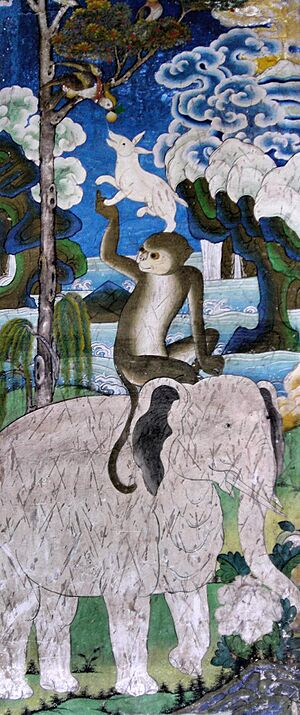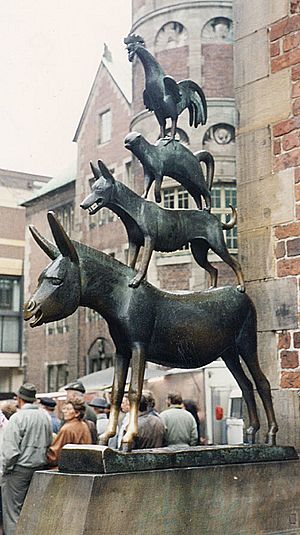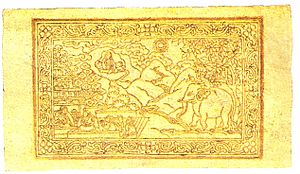Four harmonious animals facts for kids
Quick facts for kids Four harmonious animals |
|
|---|---|
| Information | |
| Religion | Buddhism |
| Language | Pāli, Sanskrit, Tibetic languages |
| Sutras | In Vinaya texts and Jātaka collections of many Buddhist canons |
The story of the four harmonious animals, also known as the four harmonious friends or four harmonious brothers, is a famous tale from Buddhist mythology. It's one of the well-known Jataka tales, which are stories about the Buddha's past lives. This story is very popular in Bhutan, Tibet, and Mongolia. You can often see it in art, like on temple murals, stupas (Buddhist monuments), and even on everyday items. It teaches important lessons about living together peacefully.
The Story of the Four Friends
Imagine an elephant standing under a fruit tree. On its back is a monkey, then a hare, and finally a bird (usually a partridge or hornbill) on top! This picture shows a famous legend. The story begins with four animals trying to figure out who was the oldest among them.
The elephant said that when he was young, the tree was already fully grown. The monkey then said that the tree was small when he was a young monkey. The hare added that he saw the tree as just a tiny sapling when he was little. Finally, the bird claimed something amazing: he had actually eaten a seed and then pooped it out, and that seed grew into this very tree!
So, the other animals agreed that the bird was the oldest and wisest. From that day on, the four animals decided to live together. They helped each other reach the fruits of the tree, showing great teamwork and respect. This story was told by the Buddha to teach his students about cooperation and respecting those with more experience.
Important Lessons from the Animals

The main message of this story is about living in peace and respecting others, especially those who are older or have more experience. It's different from a "pecking order" where the strongest or biggest animal is in charge. Here, the smallest animal, the partridge, is the most respected because of its wisdom.
The four animals also represent different parts of nature:
- The bird represents the sky.
- The monkey represents the trees.
- The hare represents the ground.
- The elephant represents underground (or the earth itself).
The partridge is seen as very smart in old Indian stories. The idea that a tree only grows when a bird eats and then excretes its seed shows how much living things depend on each other.
The image of the animals stacked on top of each other, with the patient elephant at the bottom, shows how everyone can work together. The bird finds and plants the seed. The rabbit waters it. The monkey fertilizes it. And the elephant protects the growing plant. Because they work together, the small plant grows into a big tree full of delicious fruit that they can all enjoy. This teaches us about social harmony and caring for our environment.
Where the Story Comes From

The story of the four harmonious animals comes from ancient Buddhist texts. One of the main sources is the Vinayavastu, which is part of the Tibetan Buddhist holy books. You can also find very similar versions of this tale in other Buddhist traditions, like the Pāli Canon of Theravāda Buddhism.
These stories are often found in collections called Jataka tales, which are about the Buddha's previous lives. Sometimes, the story was told as a simple parable or lesson by the Buddha, even if it wasn't always considered a story from his past life. It has been passed down through generations to teach valuable lessons about living together in peace and cooperation.


